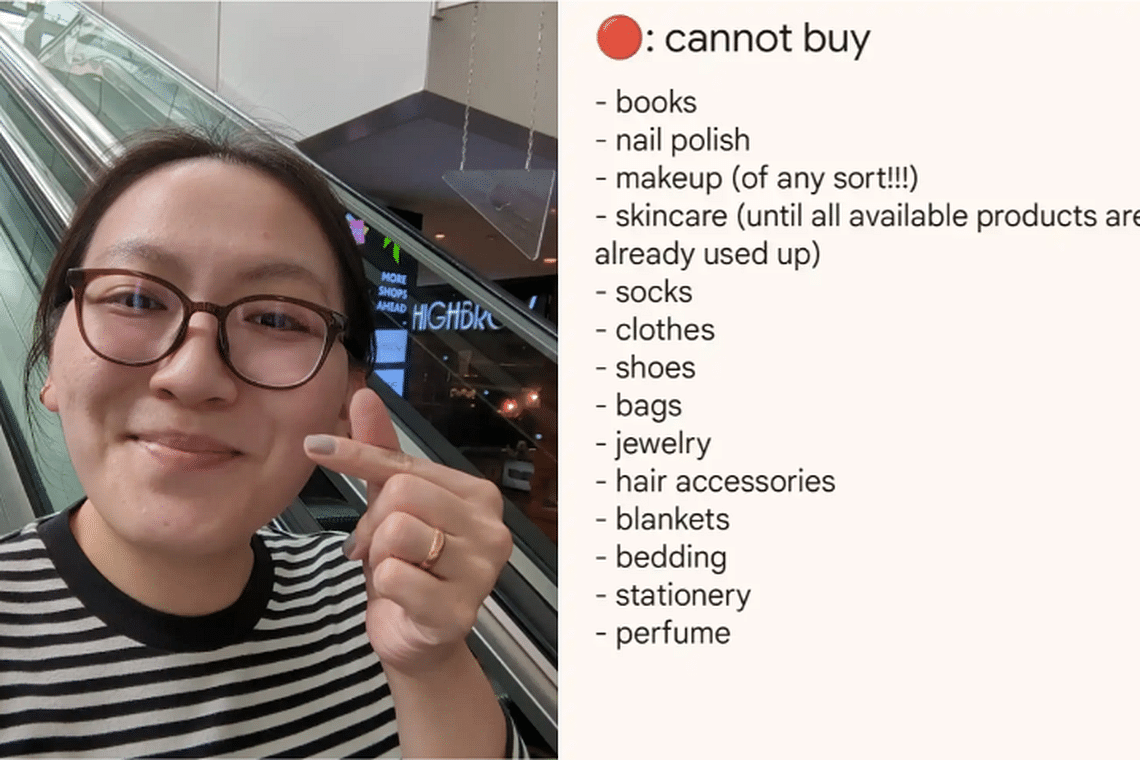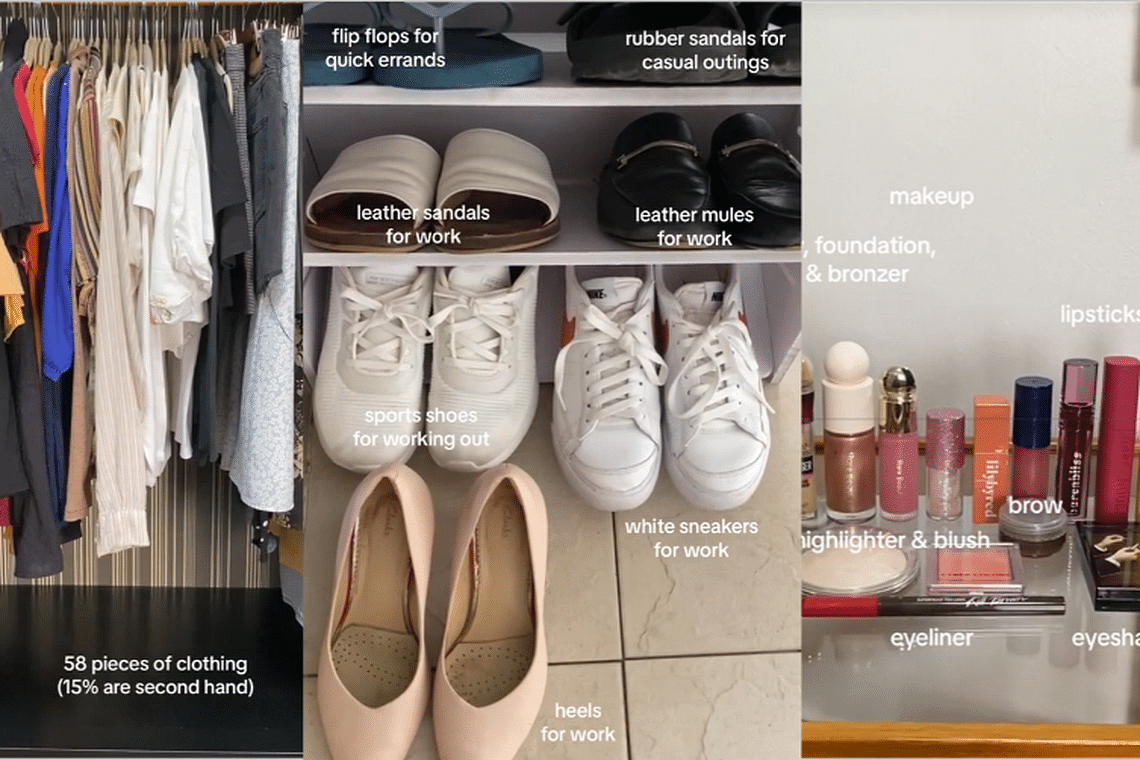SINGAPORE – When Ms Marsha Ho, a civil servant, started working five years ago, she began shopping as a way to treat herself, regardless of her mood.
The habit evolved into scrolling mindlessly on shopping apps such as Carousell for one to two hours daily.
She quickly accumulated a collection of 30 pieces of apparel, shoes and bags she did not need and chucked them into what she called a “death pile”.
The 30-year-old said shopping excited her, but she “was left with an abundance of stuff and regrets” after.
“I asked myself: ‘Why did I bring this item home?’ The pile was so overwhelming, it gave me more anxiety and stress.”
This led her to embrace the “underconsumption core” TikTok trend, where she focused on buying less, decluttering and using items she already had.
She is among a group of young people here participating in the viral trend that spotlights frugality and living sustainably. It encourages users to maximise using what they have and to buy only what they need.
On TikTok, the hashtag #underconsumptioncore boasts more than 39 million views worldwide. Instead of posting large hauls of clothing and beauty products, users are posting videos of their well-used everyday items and a downsized skincare collection.
The rise of this trend can be linked to the challenges Gen Z and millennials face today, including mounting economic pressures and environmental concerns.
In Singapore, more than nine in 10 citizens have felt the impact of the rising cost of living. The top two ways to cope with this are keeping to a fixed budget and deferring purchases until prices become affordable.

As part of her New Year’s resolution, Ms Ho committed to spending only on necessary purchases, embracing what is popularly known as the “no-buy challenge”.
The challenge involves creating a list of non-essential items one pledges not to buy for a period of time and documenting it on social media.
Ms Ho’s list included clothes, make-up and jewellery, but she allowed herself to spend on daily necessities, movies and gifts, among others.
Since she started in January, she estimates that she has saved between $100 and $150 monthly and now channels the time she would have spent on shopping on hobbies such as crocheting and reading.
A reset that was needed
Despite the progress, Ms Ho found the challenge to be more difficult than she anticipated.
She was tempted to buy an eyeshadow palette, lip gloss and dress within two months of starting the challenge, but talked herself out of purchasing them.
“I told myself that the desire and happiness of buying something new is fleeting. Besides, I have a lot of beautiful things and I should appreciate them,” Ms Ho said.
By August, she had reduced her “death pile” to just three pieces, having given away the rest to friends and users on Carousell.
The experience has helped her become a more mindful shopper and aware of her impact on global waste.
“Before the challenge, I wanted to buy things instantly and was driven by sales. But now, I have become a more thoughtful and logical shopper. It was a reset that I needed,” Ms Ho said.
Ms Jasmine Chin, a public servant, took on the challenge but tweaked it to a “low-buy challenge” for more flexibility in her spending. Before beginning her low-buy year, she spent almost two weeks in December analysing her spending habits over the previous months.
The 25-year-old identified that make-up, fashion and tech accessories from Shopee were among her shopping weaknesses.
“Last year, I was impulsively buying knick-knacks on Shopee that were on a time-based deal. They were worth 10 cents to $2, so I didn’t think it would hurt. It was when I accumulated a whole box of such items that I realised I needed to be more mindful with my consumption,” she said.
For her low-buy challenge, she spends only on essentials such as groceries, public transport, medicine and family dinners.
Ms Chin refrains from purchasing any new clothes, shoes or make-up, and avoids food delivery and digital subscriptions.
She replaces her skincare essentials only when they run out, and must deliberate for at least a week before making any new purchases.
“I ask myself: Do I need this item? Can I live without it? Can I find a replacement? I wanted to break free from buying unnecessary things, to have a more decluttered home and feel better about contributing less to the climate crisis,” she said.

She started her journey by decluttering her room, donating unwanted items through Carousell and Olio, a mobile app for giving away food and household items to the community.
To hold herself accountable, she posts monthly updates on TikTok, sharing her progress and being candid about slip-ups, such as when she bought a blazer in June.
Ms Chin said: “I broke my no-buy challenge, but to err is human. Making mistakes and the challenge have given me valuable lessons in money management.
“It taught me to be more conscious of my spending and to practise saying ‘no’ to unnecessary purchases, trends and social pressures.”
The 50-30-20 rule
Mr Aaron Chwee, head of OCBC Bank’s wealth advisory, said he is happy to see this trend, which differs from others that encourage spending, such as “buy now, pay later” plans.
He said: “Cutting down on unnecessary expenses which can be deployed to savings or investments to build funds for the future is a good foundation for financial planning. In addition, living sustainably and using what you have are virtues and are better for the planet.”
Dr Seshan Ramaswami, associate professor of marketing education at Singapore Management University, said that when making their lists, participants would be more conscious of why they are buying things. They may then realise that some purchases are to escape from deeper emotional issues, and find healthier ways to address them instead.
But Mr Chwee cautioned that excessively depriving oneself of spending could lead to binge spending.
He said: “While it can be cool to push oneself to the limit... there should also be a balance between having common sense and taking challenges to the extreme.
“You will need to be careful about pushing yourself beyond what you can mentally and materially tolerate.”
He suggested that people set aside some money each month to spend guilt-free, after putting aside money for other financial goals.
Mr Chwee added that compulsive spenders should follow a 50-30-20 rule, where half their income goes towards daily necessities and needs, 30 per cent towards their wants and pleasures and 20 per cent for a rainy day.
They can also enlist the help of an accountability partner, who can tell a person if a challenge has gone too far and provide support when old spending habits resurface.
They can also use digital tools, such as those in banking apps, to help them in budgeting and controlling impulsive spending.
Otherwise, Mr Chwee said one can find something else to do for an emotional high that does not require consumption, such as running or a sport, or seek a therapist for one’s compulsions.
Dr Ramaswami said the underconsumption trend could be a bane for retailers, whose profits are closely tied to consumer spending, but it could also create other business opportunities.
Companies involved in repairs, second-hand goods, spare parts, and do-it-yourself versions of mass-produced products could benefit from this shift in consumer behaviour.
Ms Ho said she would do the challenge again, having learnt important lessons from it.
She said: “The experience taught me to better value my time and money. Before, I had found instant gratification in shopping, but I now find spending on worthwhile and long-lasting items more fulfilling.”






No comments:
Post a Comment